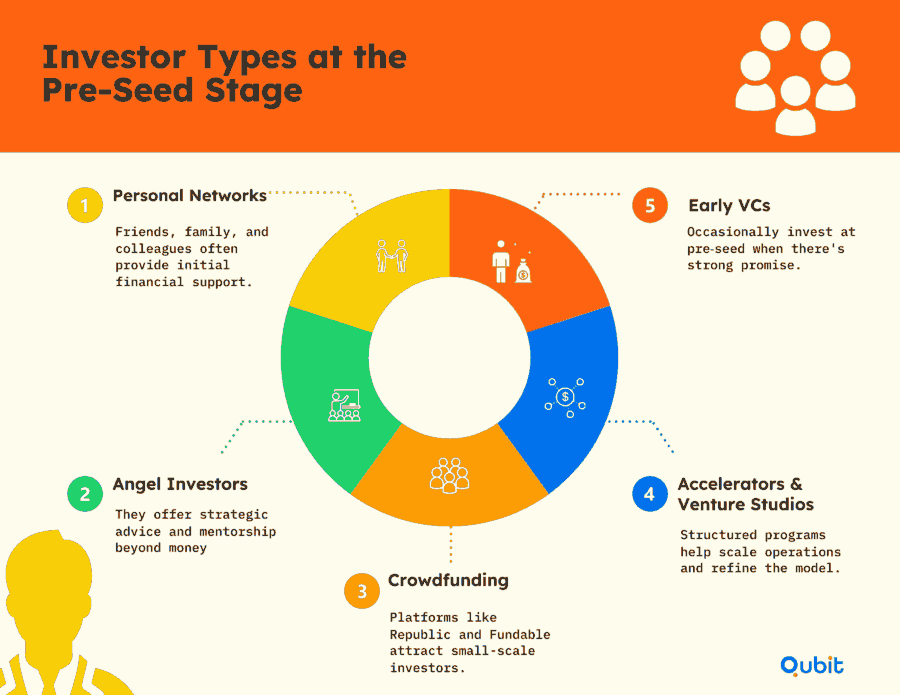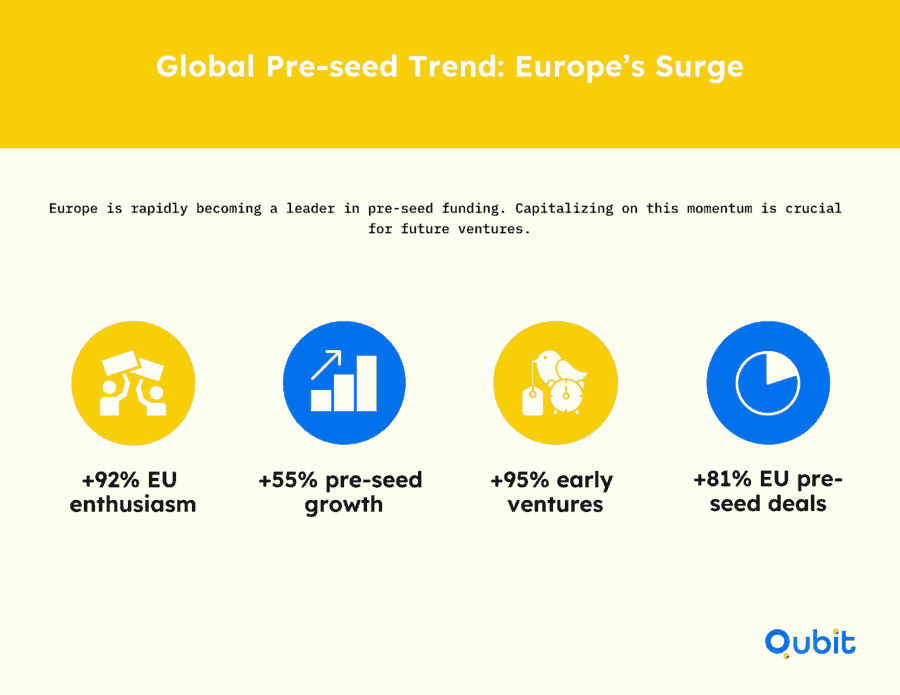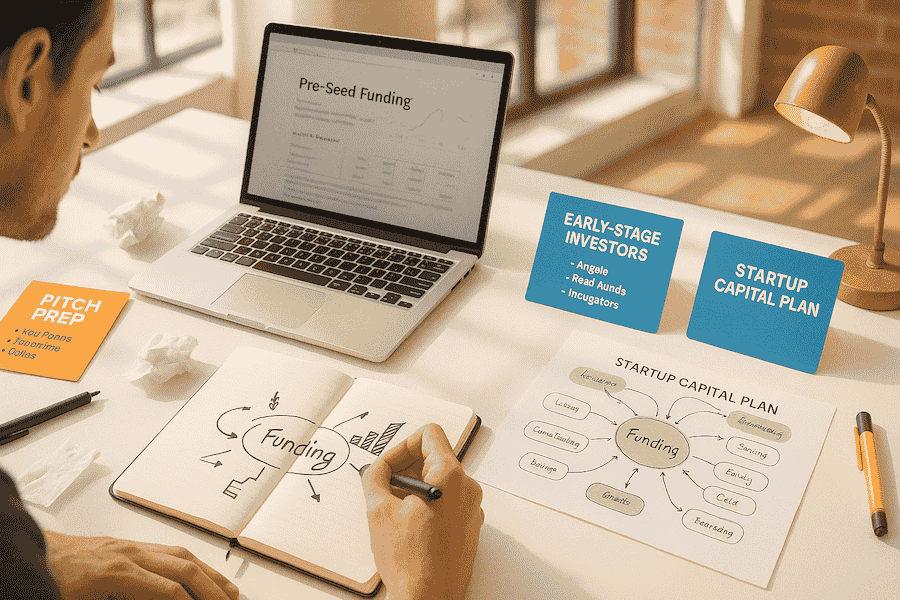Securing funding is often the first major hurdle for startups, and pre-seed funding plays a critical role in turning ideas into reality. This initial stage of capital raising is designed to help founders validate their concepts, build prototypes, and lay the groundwork for future growth. Often referred to as the "friends and family" round, pre-seed funding typically involves smaller investments from personal networks, angel investors, or early-stage venture capital firms.
Understanding the types of startup funding is essential for identifying where pre-seed fits into the broader funding ecosystem. For example, while pre-seed rounds focus on early validation, later stages aim to scale operations and expand market reach.
This guide will explore what pre-seed funding entails, why it matters, and how founders can navigate this crucial stage effectively. Let’s dive in!
What is Pre-Seed Funding?
Pre-seed funding represents the earliest stage of financial support for startups, often serving as the critical bridge between a concept and a viable product. This phase is designed to help entrepreneurs refine their ideas, build prototypes, and conduct initial market research. Unlike seed rounds, which typically require some level of market validation or revenue generation, pre-seed funding focuses on the foundational aspects of product development.
Pre-seed vs Seed
Pre-seed rounds typically raise up to $200k using convertible instruments like SAFEs (Simple Agreement for Future Equity). These flexible tools allow startups to secure funding without immediately determining valuation, which is particularly useful at this nascent stage.
The funds raised during pre-seed are often allocated to key activities such as hiring initial team members, developing a minimum viable product (MVP), and conducting market research to identify target audiences. This groundwork is essential for demonstrating the feasibility of the idea and attracting investors for subsequent funding rounds.
A notable distinction between pre-seed and seed funding lies in expectations. While pre-seed focuses on transforming ideas into tangible outcomes, seed rounds demand evidence of market validation—sometimes even early revenue. This shift underscores the growing importance of proving demand before scaling operations.
Pre-seed funding plays a pivotal role in shaping the startup's trajectory, enabling founders to test assumptions and refine their strategies before seeking larger investments. Once you’ve moved through pre‑seed funding, understanding what is seed funding helps you transition seamlessly into the next stage of raising capital.
What Investors to Expect in Your Funding Journey
Pre-seed funding often brings together a diverse array of investors, each contributing unique advantages to early-stage startups. These investors range from personal networks and angel investors to crowdfunding platforms, accelerators, venture studios, and venture capitalists. Understanding their roles can help founders identify the right fit for their business goals.

Personal Networks: The First Step
Many startups begin their funding journey with personal networks. Friends, family, and colleagues often provide initial financial support, offering not only capital but also encouragement during the critical early stages. This type of funding is typically informal, yet it can be instrumental in building momentum for larger investments.
Angel Investors: Expertise Meets Capital
Angel investors are seasoned individuals who bring both financial resources and industry expertise to the table. Their involvement often extends beyond funding, as they offer strategic advice and mentorship to help startups navigate challenges. For entrepreneurs seeking guidance alongside capital, angel investors can be invaluable.
Crowdfunding Platforms: Expanding the Investor Pool
Crowdfunding platforms like Republic and Fundable provide startups with access to a broad and diverse investor base. These platforms allow founders to pitch their ideas to everyday investors, fostering community support and generating early buzz for their ventures. Highlighting Republic as a crowdfunding option, founders can attract a mix of small-scale investors eager to support innovative ideas. Similarly, Fundable serves as another resource for early-stage startup financing, enabling entrepreneurs to secure funds while building brand visibility.
Accelerators and Venture Studios: Structured Growth
Accelerators and venture studios offer more than capital—they provide structured programs designed to refine business models, scale operations, and connect startups with industry experts. These entities are particularly beneficial for founders looking to fast-track their growth while gaining access to valuable networks.
Venture Capitalists: Scaling Ambitions
Although less common in pre-seed rounds, venture capitalists occasionally invest in promising startups at this stage. Their involvement can signal strong growth potential, as VCs often bring substantial resources and connections to help scale operations rapidly.
Entrepreneurs exploring pre-seed funding can benefit from understanding seed funding vs angel investment to identify the right partners for their growth. Each investor type offers distinct advantages, making it crucial to align funding sources with long-term business strategies.
Securing Pre-Seed Funding: Steps and Strategies
Securing pre-seed funding is a critical milestone for startups aiming to transform their ideas into viable businesses. This section explores actionable strategies to help founders attract early-stage investors and build momentum for future funding rounds.
1. Build a Compelling Pitch Deck
A well-crafted pitch deck serves as the cornerstone of your fundraising efforts. It should clearly articulate your startup’s value proposition, market opportunity, and growth potential. Founders can refine their presentations using a Pitch Deck Template, which simplifies the process of creating visually engaging and informative slides. This tool ensures your pitch resonates with investors by highlighting key elements such as your business model, competitive edge, and financial projections.
2. Network Strategically
Establishing meaningful connections with investors and industry professionals is essential during the pre-seed stage. Attend startup events, join online communities, and leverage personal networks to identify potential backers. Proactive networking not only opens doors to funding opportunities but also helps you gain valuable insights into investor expectations. Building relationships early can significantly improve your chances of securing capital.
3. Target Accelerator Programs
Accelerator programs offer startups initial validation, mentorship, and access to a network of investors. Research programs that align with your industry and growth stage, as these can provide the resources and credibility needed to attract pre-seed funding. Applying to the right accelerator can also help refine your business model and prepare you for future funding rounds.
4. Prepare for Investor Meetings
Investor meetings are your opportunity to make a lasting impression. To maximize your chances of success, ensure your pitch is concise, data-driven, and tailored to the interests of your audience. Anticipate questions about your market strategy, revenue model, and scalability, and prepare thoughtful responses. Confidence and clarity during these interactions can set you apart from other startups seeking funding.
Many founders wonder how to get seed funding after their pre-seed round, and having a clear strategy ensures smoother transitions to later funding stages.
Utilizing Pre-Seed Funding and Understanding Startup Stages
Pre-seed funding sets the foundation for turning an idea into a viable business. This initial stage of financing is typically used to cover essential startup costs such as company setup, market research, prototype development, and assembling a core team. Unlike later funding rounds, pre-seed funding focuses on validating the business concept rather than scaling operations.
What Is Pre-Seed Funding Used For?
Pre-seed funding is designed to address the most critical needs of a startup during its earliest phase. Entrepreneurs often allocate these funds to:
- Market Research: Understanding customer needs and identifying gaps in the market.
- Prototype Development: Building a minimum viable product (MVP) to test the feasibility of the idea.
- Team Building: Hiring key personnel who can contribute to the startup’s growth.
- Operational Setup: Covering legal, administrative, and infrastructure costs to establish the business framework.
How Pre-Seed Fits Into Startup Funding Stages
Pre-seed funding is the first step in the broader startup funding journey. It precedes seed funding, Series A, and subsequent rounds, each of which serves distinct purposes. While pre-seed focuses on validating the idea, later stages aim to scale operations, expand market reach, and refine the product. Understanding these differences helps founders allocate resources effectively and plan for future funding needs.
Pre-seed funding is not just about securing capital; it’s about laying the groundwork for sustainable growth. By focusing on early-stage priorities, startups can build a strong foundation to attract investors in subsequent rounds.
Common Pitfalls in Pre-Seed Fundraising
- Vague or incomplete business plan
Investors want to see a clear, detailed roadmap showing growth potential and profitability. A weak plan makes it harder to gain their trust. - Neglecting networking opportunities
Strong relationships within the startup ecosystem can lead to introductions, advice, and unexpected opportunities. Founders who stay connected usually have sharper fundraising strategies. - Ignoring investor feedback
Feedback during pitches is often valuable and specific. Brushing it off may come across as inflexible or uncoachable. - Poor preparation for due diligence
Investors will dig into everything—financials, legal docs, projections. Being unprepared signals a lack of professionalism and can delay or kill a deal.
Real-World Case Studies: Successes and Comparisons
Examining real-world examples provides clarity on how pre-seed funding can shape a startup's trajectory. Below are case studies showcasing successes and lessons learned from both pre-seed and seed funding approaches:
- Robinhood: This fintech giant raised its pre-seed round in 2012 through Y Combinator. Early funding enabled Robinhood to focus on user traction, eventually achieving a significant valuation milestone.
- Airbnb: Before becoming a household name, Airbnb secured pre-seed funding, which allowed the founders to refine their platform and validate their business model.
- Notion: By raising pre-seed capital, Notion had the flexibility to iterate on its product and establish a loyal user base before scaling further.
In contrast:
- Slack: Opted for a direct seed round, leveraging its founders' reputation to secure larger initial funding.
- Pinterest: Skipped pre-seed funding, relying on early user adoption to attract seed investors.
- Canva: Focused on building a robust MVP before raising a seed round, bypassing pre-seed altogether.
These examples highlight how pre-seed funding can foster early growth while seed rounds offer a faster path to scaling. Strong networking skills are essential for building relationships with seed investors, starting from the pre-seed stage.
Determining Your Next Funding Move
Once your pre-seed round objectives are achieved, the next steps in pre-seed funding involve refining your strategy for future growth. Begin by reassessing your business plan to ensure alignment with your long-term goals. Use investor feedback to sharpen your pitch, addressing any gaps or concerns raised during earlier discussions.
Planning for the next funding stage is crucial. Outline clear milestones that demonstrate progress and scalability, making your venture more attractive to potential investors.
By focusing on these actionable steps, you can position your startup for success in subsequent funding rounds while maintaining momentum in your growth journey.
Branding and Investor Relations
A compelling brand story can transform investor perceptions, fostering trust and confidence in your startup. By crafting a unique identity, you not only differentiate yourself in a crowded market but also signal stability and vision—qualities investors seek when evaluating pre-seed opportunities. Strong branding communicates your startup’s mission and potential, making it easier to secure capital and build lasting relationships.
Effective investor relations go beyond financial metrics; they hinge on the emotional connection your brand establishes. A well-defined pre-seed branding strategy ensures your startup stands out, inspiring confidence and aligning with investor expectations for growth and innovation.
Global Trends in Pre-Seed Funding: Europe's Rise
Investor enthusiasm for early-stage ventures is surging across Europe, marking a significant shift in global funding dynamics. European pre-seed rounds have expanded rapidly, reflecting rising investor confidence and a thriving startup ecosystem. This growth is not only reshaping the region's entrepreneurial landscape but also positioning Europe as a key player in global funding trends.

As more investors increasingly back early-stage ventures, the amounts raised in European pre-seed rounds continue to climb. This trend underscores the region's ability to foster innovation and attract capital, solidifying its role in the global startup economy.
Conclusion
Securing pre-seed funding is a pivotal milestone for any startup. By mastering the fundamentals of pre-seed funding, identifying diverse investor types, and taking actionable steps, founders can set themselves up for success. Avoiding common pitfalls, such as unclear goals or weak pitches, is equally important.
A compelling pitch, thorough planning, and strong branding are essential to stand out and secure the funding needed to grow. These elements not only attract investors but also build the foundation for transitioning smoothly into later funding rounds.
At Qubit Capital, we understand the challenges of early-stage fundraising. If you're ready to elevate your pre-seed journey, our Fundraising Assistance service is here to guide you every step of the way. Let us help you turn insights into action and move closer to achieving your startup’s vision.
Key Takeaways
- Pre‑seed funding transforms early ideas into viable products using convertible instruments like SAFEs.
- A variety of investors—from friends and family to angels and crowdfunding—offer unique advantages.
- Strategic steps such as developing a pitch deck and proactive networking are crucial.
- Avoid common pitfalls by preparing a clear business plan and thorough due diligence.
- Strong branding and understanding global trends, especially in Europe, can significantly enhance investor confidence.
Frequently asked Questions
How does pre‑seed funding work?
Pre‑seed funding provides the initial capital needed to turn a concept into reality. This stage typically involves smaller investments and is often facilitated through convertible instruments like SAFEs (Simple Agreements for Future Equity). The primary focus is on validating the idea and developing a minimum viable product (MVP).


 Back
Back



